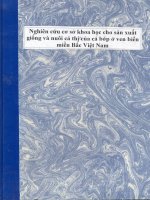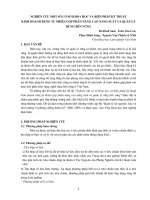GENERATION AND MIGRATION OF HYDROCARBON (cơ sở KHOA học địa CHẤT dầu KHÍ SLIDE TIẾNG ANH)
Bạn đang xem bản rút gọn của tài liệu. Xem và tải ngay bản đầy đủ của tài liệu tại đây (751.59 KB, 82 trang )
CHAPTER 05
GENERATION AND MIGRATION
OF HYDROCARBON
1- GENERATION OF
HYDROCARBON
1.1-Petroleum Source Material
1.1.1-Formation and Preservation of
Organic Matter
• In the nineteenth century, it was widely
believed that petroleum had a magmatic
origin and that it migrated from great
depths along subcrustal faults.
• But the overwhelming evidence now
suggests that the original source
material of petroleum is organic matter
formed at the earth's surface.
• The process begins with photosynthesis,
in which plants, in the presence of
sunlight, convert water and carbon
dioxide into glucose, water and oxygen:
6CO2 + 12H2O
6O2
C6H12O6 + 6H2O +
• Photosynthesis is part of the larger-scale
carbon cycle (Fig. 01). Ordinarily, most of
the organic matter produced by
photosynthesis gets recycled back to the
atmosphere as carbon dioxide. This can
occur through plant and animal
respiration, or through oxidation and
bacterial decay when organisms die
Fig 01-CARBON CYCLE
1.1.2-Preservation and Organic
Productivity
• All organic matter in the ocean is
originally formed through
photosynthesis. The main producers are
phytoplankton, which are microscopic
floating plants such as diatoms,
dinoflagellates and the blue-green
algae. Bottom-dwelling algae are also
major contributors in shallow water,
shelf environments.
1.1.3-Preservation and Organic
Destruction
• Areas of high productivity are not
necessarily those best suited for
preservation. Destruction of organic
matter must also be prevented.
Complete biological recycling of organic
carbon is retarded by anything that
limits the supply of elemental oxygen.
• This occurs most favorably in either one
of two settings: rapid rate of deposition;
and stratified, oxygen-poor water bodies
with anoxic bottoms
• First, rapid deposition may be necessary to
keep the organic material from being
destroyed.
• Preservation is also favored by density
stratification, which produces oxygen-poor
bottom waters.
• Water stratification and oxygen depletion
are well known in the modern Black Sea,
• The Eocene-age lakes of Utah, Colorado and
Wyoming, in which the Green River oil shale
formation was deposited, have been
interpreted as seasonally stratified water
bodies which at a later stage become
permanently stratified (Fig 02)
Fig 02
• In the present-day world's oceans, there
is a zone of maximum oxygen depletion
at a depth of about 200 meters, with
oxygen more abundant in the shallow
surface waters and again at deeper
levels (Figure 03)
Fig 03
Oxygen-minimum
layer (OML)
This is an oxygendeficient layer, often
within a large body of
water. The OML, in
varying
oxygen
deficiencies,
is
common to oceans; it
generally lies below the
photic zone and it can
be
underlain
by
deeper,
oxygenated
water
(Figure
…,
Oxygen
minimum
layer.
1.1.4-Diagenesis of Organic Matter
• There are three important stages in the
burial and evolution of organic matter
into hydrocarbons:
– diagenesis;
– catagenesis;
– and metagenesis.
Modern Organic Processes at
the Earth’s Surface
• Surface
– 82% C locked into CO3 in carbonates
– 18% occurs as organic C in coal, oil & gas
– When death occurs, a plant or animals remains are
normally oxidized and CO2/ H2O released
• Subsurface
– When death occurs, a plant or animals remains are
normally oxidized and CO2/ H2O released
– Under exceptional conditions: organic matter is buried
and preserved in sediments
– The composition of the organic matter strongly
influences whether the organic matter can produce coal,
oil or gas.
Basic components of organic
matter in sediments
• PROTEINS
– More abundant in animals: O, C, N, H
• CARBOHYDRATES
– Occur in both. Cn(H2O)n
– sugars, cellulose, starch
• LIPIDS (Fats)
– Occur in both: C, H, O
– Fats, oils, waxes (e.g. leaf cuticles)
• LIGNIN
– Occurs in plants: complex aromatic ring structures, large
molecules
All of these + Time + Temperature + Pressure =
KEROGEN
Diagenesis of Organic Matter
Diagenesis of organic matter begins as soon as
sediment is buried. However, the point at
which diagenesis ends is subject to how the
term is used. Some geologists use the term in
a restricted sense to include only processes
that occur as sediment consolidates into
sedimentary rock.
Others expand the realm of diagenesis to
include all processes extending up to, and
blending imperceptibly into, regional
metamorphism.
In this discussion, diagenesis is defined on the
basis of organic matter, and it includes all
changes that occur up to the stage of
petroleum generation.
• Freshly deposited muds are
unconsolidated and may contain more
than 80% water in their pores. These
muds compact very quickly. Most of
the porosity is lost in the first 500
meters of burial (Figure 04). After
that, compaction to form mudstones or
shales continues much more slowly.
Fig 04
1.1.5-Kerogen Components
• Under the microscope, kerogen appears
as disseminated organic fragments. Some
of this material is structured. It is
recognizable as plant tissue fragments,
spores, algae, and other pieces with a
definite biological organization. These
plant-derived structured fragments can
be grouped into distinct biological units
called macerals. Macerals in kerogen are
equivalent to minerals in rocks.
• Three major maceral groups are
important: vitrinite, exinite and inertinite.
Kerogen Components
•Vitrinite is the dominant maceral type in many
kerogens and is the major component of coal. It is
derived almost entirely from woody tissue of the higher
land plants. Because it is derived from lignin and is
difficult to break down, vitrinite can appear in almost
any depositional environment, marine or nonmarine,
and is generally the most abundant type of structured
particle.
•Exinite macerals are mainly derived from algae,
spores, pollen, and leaf-cuticle waxes. High percentages
of exinite are not common, but if present, they usually
imply lacustrine or shallow marine environments.
•Inertinite macerals come from various sources that
have been extensively oxidized before deposition.
Charcoal, derived from woody plants, is the major
recognizable type. Inertinite is usually a minor
component of kerogen, and is abundant only where
much of the organic matter has been recycled.
Kerogen Components
• In addition to the structured macerals,
some of the components of kerogen are
amorphous. Amorphous particles have
been so mechanically broken up and/or
chemically altered by bacteria and
fungi that their original maceral types
and cell structures have been
obliterated -Amorphous particles are
not true macerals but alteration
products, although the maceral term
"amorphinite" has sometimes been
applied to these materials.
1.2-Hydrocarbons and Kerogen
•Type
The macerals and amorphous particles in
kerogen affect its ability to generate
hydrocarbons.
• Oil-prone kerogens generally are made of
more than 65% exinite and amorphous
particles (Figure 05).
• Kerogens with 65% to 35% of oil-prone
components will expel mostly
condensate and wet gas. With less than
35% oil-prone constituents, the kerogen
will yield dry gas if dominated by
vitrinite and will be non-reactive and
barren if dominated by inertinite.
Figure 05- Types of petroleum generated from
kerogen, based on visual analysis with reflected
light microscope
The oil-prone kerogens can be
divided into four types:
• Type I, or algal kerogen (Table 1),
is rich in the algal components of
exinite, and is formed in either
lacustrine or marine
environments. Type I kerogen is
derived mainly from lipids and
tends to produce crudes that are
rich in saturated hydrocarbons.
Kerogen Type
Origin
Organic Constituents
I Algal
Algae of marine, lacustrine,
boghead coal environments
Mostly algal components: of
exinite (alginite); some
amorphous material derived
from algae
II Mixed Marine
Decomposition in reducing
environments, mostly marine
Amorphous particles derived
mostly from phytoplankton,
zooplankton, and higher
organisms; also some macerals
from these groups
III Coaly
Debris of continental vegetation
(wood, spores, leaf cuticle wax,
resin, plant tissue )
Mostly vitrinite; some exinite
(not algal) and amorphous
decomposition products
IV Inert
Fossil charcoal and other
oxidized material of continental
vegetation
Mostly inertinite; some
amorphous decomposition
products
Table 1 Kerogen types, their origin, and
organic particle constituents









